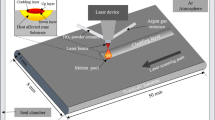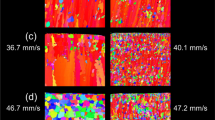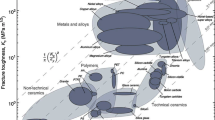Abstract
As-annealed commercial pure titanium (grade 1) was selected as a model material whose crystalline structure was hexagonal close-packed. The evolution of the microstructure and micro-orientation induced by high-speed compression was characterized to elaborate the formation mechanism of the high-speed deformation characteristic microstructure in α-titanium. Twinning played a coordinating role for dislocation slipping that was the main plastic deformation mechanism. The high-speed deformation characteristic microstructure of as-annealed commercial pure titanium was an adiabatic shear band (ASB) with an average width of 50 μm at a strain rate of 5400 s−1, whose initial grains were 0.5–1.0 μm in size. The formation and extension of ASB were attributed to the interaction between the shear stress and the adiabatic temperature rise. A formation model of ASB in α-Ti was proposed in terms of the formation mechanism of the high-speed deformation characteristic microstructure.













Similar content being viewed by others
References
Y.B. Xu and Y.L. Bai: Shear localization, microstructure evolution and fracture under high-strain rate. Adv. Appl. Mech. 37, 496 (2007).
Y.L. Bai, Q. Xue, Y.B. Xu, and L.T. Shen: Characteristics and microstructure in the evolution of shear localization in Ti–6A1–4V alloy. Mech. Mater. 17, 155 (1994).
S.W. Xu, S. Kamado, and T. Honma: Recrystallization mechanism and the relationship between grain size and Zener–Hollomon parameter of Mg–Al–Zn–Ca alloys during hot compression. Scr. Mater. 63, 293 (2010).
U. Andrade and M.A. Meyers: Dynamic recrystallization in high-strain, high strain rate plastic deformation of copper. Acta Mater. 42, 3183 (1988).
J.A. Hines: A model for microstructure evolution in adiabatic shear bands. Metall. Mater. Trans. A 29, 191 (1998).
V.F. Nesterenko and M.A. Meyers: Shear localization and recrystallization in high-strain, high-strain-rate deformation of tantalum. Mater. Sci. Eng., A 229, 23 (1997).
J.A. Hines and K.S. Vecchio: Recrystallization kinetics within adiabatic shear bands. Acta Mater. 45, 635 (1997).
H.J. Mcqueen: Initiating nucleation of dynamic recrystallization, primarily in polycrystals. Mater. Sci. Eng., A 101, 149 (1988).
Y.B. Xu, J.H. Zhang, and Y.L. Bai: Shear localization in dynamic deformation: Microstructural evolution. Mater. Trans. A 39A, 811 (2008).
L.E. Murr, A.C. Ramire, S.M. Gaytan, M.I. Lope, E.Y. Martinez, D.H. Hernande, and E. Martine: Microstructure evolution associated with adiabatic shear bands and shear band failure in ballistic plug formation in Ti–6Al–4V targets. Mater. Sci. Eng., A 516, 205 (2009).
D. Banerjeea and J.C. Williams: Perspectives on titanium science and technology. Acta Mater. 61, 844 (2013).
P. Ge, Y.Q. Zhao, and L. Zhou: Material development as viewed from study of titanium alloys used in missile warhead. Mater. Rev. 17, 26 (2003).
Y. Yang and B.F. Wang: Dynamic recrystallization in adiabatic shear band in α-titanium. Mater. Lett. 60, 2198 (2006).
Y.B. Xu, Y.L. Bai, and M. Meyers: Deformation, phase transformation and recrystallization in the shear bands induced by high-strain rate loading in titanium and its alloys. J. Mater. Sci. Technol. 22, 737 (2006).
J. Peirs, W. Tirry, B. Amin-Ahmadi, F. Coghec, P. Verleysen, L. Rabet, D. Schryvers, and J. Degrieck: Microstructure of adiabatic shear bands in Ti6Al4V. Mater. Charact. 75, 79 (2013).
B. Bhav Singh and G. Sukumar: Effect of heat treatment on ballistic impact behavior of Ti–6Al–4V against 7.62 mm deformable projectile. Mater. Des. 36, 640 (2016).
Q. Li, Y.B. Xu, and M.N. Bassim: Dynamic mechanical behavior of pure titanium. J. Mater. Process. Technol. 155–156, 1889 (2004).
Y. Yang, X.M. Zhang, Z.H. Li, and Q.Y. Li: Adiabatic shearing phenomenon of titanium under explosion clad shock loading. J. Cent. South Inst. Min. Metall. 25, 485 (1994).
Z.Z. Peng, S. Jonsson, and H.J. Roven: The effects of deformation conditions on microstructure and texture of commercially pure Ti. Acta Mater. 57, 5822 (2009).
N.P. Gurao, R. Kapoor, and S. Suwas: Deformation behavior of commercially pure titanium at extreme strain rate. Acta Mater. 59, 3431 (2001).
J. Tu, X.Y. Zhang, C. Lou, and Q. Liu: HREM investigation of {10−12} twin boundary and interface defects in deformed polycrystalline cobalt. Phil. Mag. Lett. 93, 292 (2013).
X.Y. Zhang, J. Tu, and Q. Liu: High-resolution electron microscopy study of the {10−11} twin boundary and twinning dislocation analysis in deformed polycrystalline cobalt. Scr. Mater. 67, 991 (2012).
Y.Z. Chang: Anisotropy and Microstructural Observation of the Dynamic Mechanical Properties of Pure Titanium under High Strain Rate in TA2 (Central South University, Changsha, 2008).
M.H. Yoo: Slip, twinning, and fracture in hexagonal close-packed metals. Metall. Mater. Trans. A 12A, 409 (1981).
L. Daridona, O. Oussouaddib, and S. Ahzi: Influence of the material constitutive models on the adiabatic shear band spacing: MTS, power law and Johnson–cook models. Int. J. Solids Struct. 41, 3109 (2004).
T.B. Wang, B.L. Li, Z.Q. Wang, Y.C. Li, and Z.R. Nie: Influence mechanism of the initial dislocation boundary on the adiabatic shear sensitivity of commercial pure titanium. Mater. Sci. Eng., A 676, 1 (2016).
Y.B. Xu, W.L. Zhong, and Y.J. Chen: Shear localization and recrystallization in dynamic deformation of 8090 Al–Li alloy. Mater. Sci. Eng., A 299, 287 (2001).
ACKNOWLEDGMENTS
This research was supported by the National Natural Science Foundation of China (Project No. 51371013) and Beijing Municipal Natural Science Foundation (Project No. 2162004).
Author information
Authors and Affiliations
Corresponding authors
Rights and permissions
About this article
Cite this article
Wang, T., Li, B., Wang, Z. et al. Formation mechanism of the high-speed deformation characteristic microstructure based on dislocation slipping and twinning in α-titanium. Journal of Materials Research 31, 3907–3918 (2016). https://doi.org/10.1557/jmr.2016.409
Received:
Accepted:
Published:
Issue Date:
DOI: https://doi.org/10.1557/jmr.2016.409




